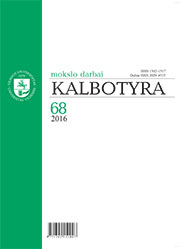Lokalizacijos raiška lietuviškojoje Georgo Wenkerio medžiagoje
Expression of localization in Lithuanian translations compiled by George Wenker
Author(s): Daiva Kardelytė-GrinevičienėSubject(s): Historical Linguistics, Comparative Linguistics, Sociolinguistics, Baltic Languages, Translation Studies
Published by: Vilniaus Universiteto Leidykla
Keywords: George Wenker; dialect; spatial scene; container; trajector; landmark; prepositional construction;
Summary/Abstract: The present study deals with the expression of localization in the German-Lithuanian translations compiled by George Wenker in the years 1879 to 1890 in the villages of Minor Lithuania, which used to be part of the German territory. The whole corpus of the translations comprises 59 pages; each page contains 40 sentences written in High German and translated into Lithuanian. Since almost half of the German sentences (their overall number is 557) illustrate localization in space, the present study focuses on 14 German sentences exemplifying spatial relations of different complexity and examines their Lithuanian translations. The aim of the study is to investigate the means of expression of spatial relations in the German-Lithuanian translations, to analyze their motivation and authenticity within the framework of cognitive semantics, namely the theory of meaning construction and interpretation. A comparative method is applied in order to identify the authenticity of the means of expression. In the first stage of the qualitative analysis a spatial scene was identified and illustrated in a general image schema in the German original sentences. The second stage of the analysis involved the conceptualization of spatial relations and their means of expression in the Lithuanian translations. The study explored the inventory of expressions of localization in the Lithuanian translations, their choice and authenticity. The findings show that the trajector or its movement towards a landmark is realized by prepositional constructions. The latter may co-occur with adverbs specifying spatial relations, which are also attested in the German originals. Place or direction is rarely marked by inessive and illative case. A variety of correspondences found in the Lithuanian translations may be dependent on the complexity of spatial scenes attested in the German originals. Simple spatial scenes involving one or two trajectors or their movement towards a landmark are rendered by prototypical expressions. Specified by additional reference to place in the German originals, they are most frequently translated literally. The translations of complex spatial scenes display the widest variety of correspondences which may represent literal or free translation. Prototypical expressions of localization were chosen when translating simple spatial scenes, whereas literal translation was more common when rendering complex scenes or simple scenes containing additional reference to place. However, literal translation may as well mirror the translatorʼs dialect, which shows alternative expressions of localization.
Journal: Kalbotyra
- Issue Year: 2016
- Issue No: 68
- Page Range: 67-95
- Page Count: 29
- Language: Lithuanian

